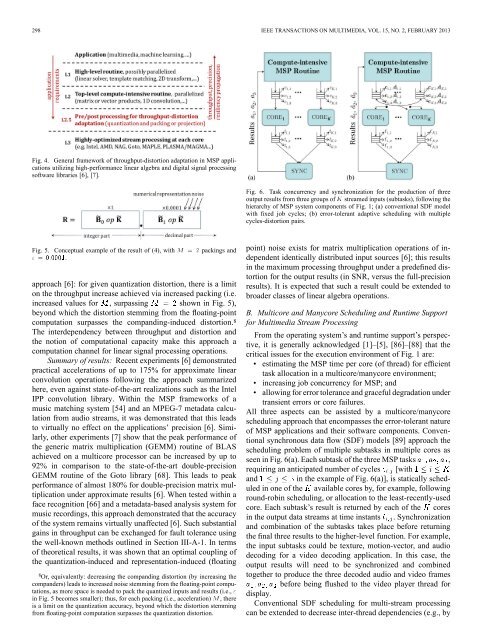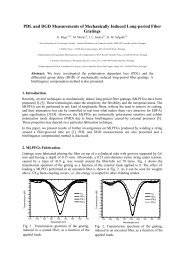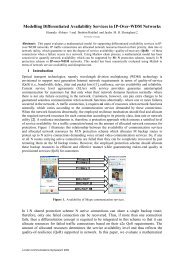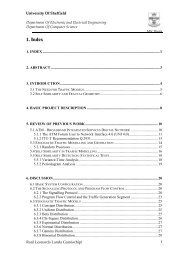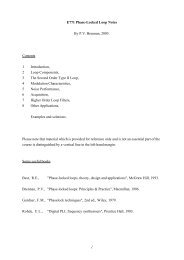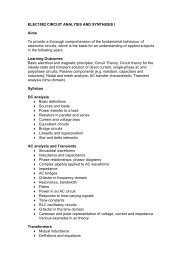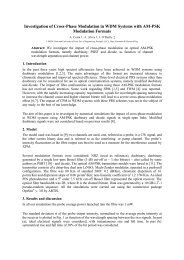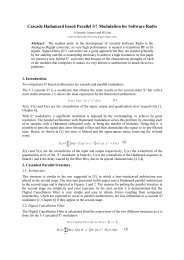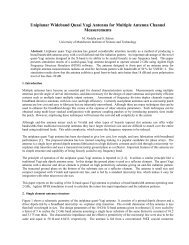298 <strong>IEEE</strong> TRANSACTIONS ON MULTIMEDIA, VOL. 15, NO. 2, FEBRUARY 2013Fig. 4. General framework of throughput-distortion adaptation in MSP applicationsutilizing high-performance linear algebra and digital signal processingsoftware libraries [6], [7].Fig. 6. Task concurrency and synchronization for the production of threeoutput results from three groups of streamed inputs (subtasks), following thehierarchy of MSP system components of Fig. 1; (a) conventional SDF modelwith fixed job cycles; (b) error-tolerant adaptive scheduling with multiplecycles-distortion pairs.Fig. 5. Conceptual example of the result of (4), with packings and.approach [6]: for given quantization distortion, there is a limiton the throughput increase achieved via increased packing (i.e.increased values for , surpassing showninFig.5),beyond which the distortion stemming from the floating-pointcomputation surpasses the companding-induced distortion. 8The interdependency between throughput and distortion andthe notion of computational capacity make this approach acomputation channel for linear signal processing operations.Summary of results: Recent experiments [6] demonstratedpractical accelerations of up to 175% for approximate linearconvolution operations following the approach summarizedhere, even against state-of-the-art realizations such as the IntelIPP convolution library. Within the MSP frameworks of amusic matching system [54] and an MPEG-7 metadata calculationfrom audio streams, it was demonstrated that this leadsto virtually no effect on the applications’ precision [6]. Similarly,other experiments [7] show that the peak performance ofthe generic matrix multiplication (GEMM) routine of BLASachieved on a multicore processor can be increased by up to92% in comparison to the state-of-the-art double-precisionGEMM routine of the Goto library [68]. This leads to peakperformance of almost 180% for double-precision matrix multiplicationunder approximate results [6]. When tested within aface recognition [66] and a metadata-based analysis system formusic recordings, this approach demonstrated that the accuracyof the system remains virtually unaffected [6]. Such substantialgains in throughput can be exchanged for fault tolerance usingthe well-known methods outlined in Section III-A-1. In termsof theoretical results, it was shown that an optimal coupling ofthe quantization-induced and representation-induced (floating8 Or, equivalently: decreasing the companding distortion (by increasing thecompanders) leads to increased noise stemming from the floating-point computations,as more space is needed to pack the quantized inputs and results (i.e.,in Fig. 5 becomes smaller); thus, for each packing (i.e., acceleration) ,thereis a limit on the quantization accuracy, beyond which the distortion stemmingfrom floating-point computation surpasses the quantization distortion.point) noise exists for matrix multiplication operations of independentidentically distributed input sources [6]; this resultsin the maximum processing throughput under a predefined distortionfor the output results (in SNR, versus the full-precisionresults). It is expected that such a result could be extended tobroader classes of linear algebra operations.B. Multicore and Manycore Scheduling and Runtime Supportfor <strong>Multimedia</strong> <strong>Stream</strong> <strong>Processing</strong>From the operating system’s and runtime support’s perspective,it is generally acknowledged [1]–[5], [86]–[88] that thecritical issues for the execution environment of Fig. 1 are:• estimating the MSP time per core (of thread) for efficienttask allocation in a multicore/manycore environment;• increasing job concurrency for MSP; and• allowing for error tolerance and graceful degradation undertransient errors or core failures.All three aspects can be assisted by a multicore/manycorescheduling approach that encompasses the error-tolerant natureof MSP applications and their software components. Conventionalsynchronous data flow (SDF) models [89] approach thescheduling problem of multiple subtasks in multiple cores asseen in Fig. 6(a). Each subtask of the three MSP tasks ,requiring an anticipated number of cycles [withand in the example of Fig. 6(a)], is statically scheduledin one of the available cores by, for example, followinground-robin scheduling, or allocation to the least-recently-usedcore. Each subtask’s result is returned by each of the coresin the output data streams at time instants . Synchronizationand combination of the subtasks takes place before returningthe final three results to the higher-level function. For example,the input subtasks could be texture, motion-vector, and audiodecoding for a video decoding application. In this case, theoutput results will need to be synchronized and combinedtogether to produce the three decoded audio and video framesbefore being flushed to the video player thread fordisplay.Conventional SDF scheduling for multi-stream processingcan be extended to decrease inter-thread dependencies (e.g., by
ANDREOPOULOS: ERROR TOLERANT MULTIMEDIA STREAM PROCESSING: THERE’S PLENTY OF ROOM AT THE TOP (OF THE SYSTEM STACK) 299duplicating some data structures accessed by multiple threads),to replicate tasks of a different core if the current core finished itsexecution flow and remains idle (for fault tolerance purposes),to increase cache efficiency by increasing data locality (e.g.,stripe-based processing in video frames), etc. The work of Liet al. [90] comprises a good academic overview of such techniqueswithin the context of video analysis and data miningapplications. Moreover, the MapReduce system proposed byGoogle [88] provides the most prevalent practical system exemplifyingsuch distributed, fault-tolerant scheduling. MapReduceperforms massively parallel stream processing tasks overcomputing clusters by splitting each input stream into multiplepieces, assigning multiple map and reduce tasks to individualworkers (that are copies of the algorithm to be performed oneach piece) and producing the results of each task into distinctoutput files [88]. The map functionality maintains the key/valuepairs that need to be maintained in memory in order for thecompilationof the final results to be successful. The crucial aspectsthat make MapReduce interesting are the massive scaling potentialand the fact that it hides the details of parallelization,fault tolerance, locality and load optimization from the user, thusmaking it easy to use [88]. The inherently redundant and distributednature of MapReduce allows for robustness to unequalload balancing and network interruptions, as multiple copies andmultiple key/value pairs are kept in different parts of the computingcluster. This also makes the overall computation immuneto sporadic core failures.Whether for a single computing cluster or for a set of clusters,error-tolerant scheduling can encompass a significantly-highernumber of possible cycles’ budgets, characterized by vectors, which are coupled with the corresponding expected distortionimpact (indicated by vectors ) causedintheparticularMSP element when the core processing utilizes a differentcycle count. The variability in cycles-distortion operationalpoints can occur due to: (i) hardware-induced errors; (ii)the error-tolerance capabilities of the application itself; (iii)thethroughput-distortion scaling capabilities allowed by the signalprocessing or linear algebra computational kernel as illustratedin the previous subsection. This error-tolerant scheduling scenariois shown in Fig. 6(b). Depending on the particular coreconfiguration and the utilized cycles, the resulting output datastreams are produced at times (that will be different fromthe original times ) and will be synchronized and combinedtogether to return the final three results (which arepotentially approximate, i.e., ) to the higher-level MSProutine.Such error-tolerant scheduling creates a significantly-largerexploration space where resilience-distortion-complexity tradeoffscan be formed based on the adopted scheduling approach.We summarize here some of the recent work in this area. Liuet al. investigated fault-generating processors under schedulingwith multiple possible voltage (frequency) levels for each core[89]. It is shown that, despite being an NP-complete problem,a near optimal scheduling solution (in terms of minimum energyefficiency and maximum resiliency to transient hardwareerrors) can be accomplished in polynomial time. In this issue,Mastronarde et al. [87] propose a dynamic scheduling solutionbased on the formulation of the scheduling problem as aMarkov decision process. Validation is performed by simulationswith a multi-processor architecture that allows for dynamicpower scaling. Leem et al. [91] propose the error-resilientsystem architecture (ERSA) framework for high error resilienceto high-order bit errors in inputs of probabilistic clusteringaimed at recognition and mining systems. Under robustscheduling in a multicore environment, it is shown that ERSAretains high accuracy even under very high error rates for theinput streams. Subramanyan et al. [92] propose error-tolerantscheduling by extending the conventional concept of redundantthread execution to include feedback from the leading threadto the trailing thread. This means that the high parallelizationpossible in modern multicore and manycore processor environmentsisusedmoreefficientlysince the overall execution ofthe two threads remains robust to transient errors while the executiontime is accelerated due to the collaborative exchangeof messages between the two threads executing the same MSPalgorithm. Liu et al. [89] propose to extend the error-tolerantSDF model of Fig. 6(b) to include reconfiguration at the corelevel itself, based on FPGA realizations. For correlated multistreamprocessing, significant improvement in throughput perunit-area of hardware is demonstrated against the static SDFscheduling of Fig. 6(a). Finally, Anastasia and Andreopoulos[31] demonstrate energy-distortion tradeoffs by combining incrementalcomputation with time-drivenexecutionviaacontrolthread that terminates the execution of the multimedia processingthread once the allocated time (or number of cycles) hasbeen surpassed. Due to the inherent robustness of incrementalcomputation, graceful degradation is achieved in the output resultseven under aggressive scheduler-driven termination of theexecution with no performance penalty against the conventional(non-incremental) computation of the MSP algorithm.C. <strong>Error</strong>-<strong>Tolerant</strong> Architecture, Hardware Components andCross-Layer ReliabilityWithin system-level design, all conventional CMOS-basedtechnologies ensure that processor chips remain fault-freeduring their lifetime. This has shaped the commonly acceptednotion of “digital” in applications as being “lossless”, despitethe fact that: (i) all practical multimedia inputs (such asimage/video samples or other sensor-derived data) are approximationsof the physical reality; (ii) perfect reliability (andbit-level reproducibility of linear algebra routines) now comesat considerable cost (chip designers today have highly-complexfault detection mechanisms in their design and fabrication flows[55]); and (iii) the fundamental scaling limitations of CMOStechnology will lead to significantly-increased fault rates forSRAM and latch circuits below 22 nm [86]. For these reasons,an emerging field of cross-layer system reliability research[1] is now gaining significant traction. This concept distinguishesbetween error-tolerant and error-intolerant applications(e.g., safety-critical applications). <strong>Error</strong>s can be controlledat different layers of the system stack [93], [94], [95]. Forexample, error detection can be entirely be implemented inhardware while error recovery can done within a combinedhardware/architecture/application approach [95]. This has theadvantage of leveraging the energy and cycles’ overhead for thedetection and correction of hardware-induced errors betweenthe application, architecture and hardware component layers.In such cases, chip-level or component-level error analysis and


